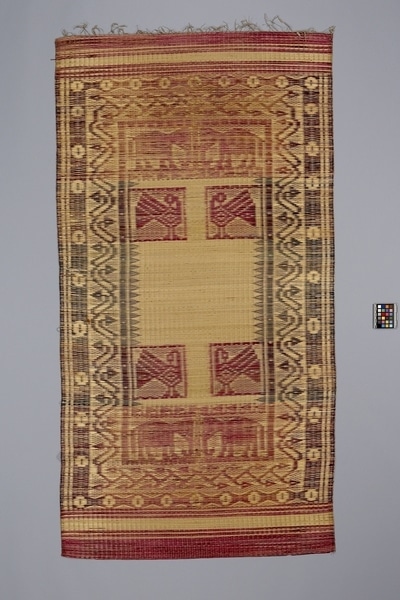Mat Item Number: Ef130 from the MOA: University of British Columbia

Description
Rectangular grass mat of fine regular weave. The mat is natural coloured with designs in red-purple and blue-green. In the centre is a rectangle with a peacock motif in each corner. Outside the rectangle are inward-facing elephant motifs. The thick border around the sides has a vine and leaf motif. The ends of the mat have red bands.
History Of Use
The antiquity of woven mats in India is supported by archaeological evidence and references in ancient texts. Mats are among the most important of household items in every strata of society. They are essential to most domestic activities and used in sleeping, eating sitting, and entertaining. The finest mats of West Bengal are woven of madur grass, grown and harvested by weavers of Hindu cultivator castes. The crop is soaked, removed of its outer cover, split into strips to be woven on a simple frame floor loom utilizing string warp. The mat is polished on 1 side. This village based industry is now assisted by the West Bengal Home Industry Board to establish cooperatives for transport and marketing of mats.
Iconographic Meaning
Ancient and auspicious symbols: peacock vehicle of the Hindu god Kartikeya, 2nd son of Shiva, symbol of Krishna. Elephant vehicle of Indra, associated with the god Ganesh and good luck.
Cultural Context
floor covering
Item History
- Made in Kholaberia, West Bengal, India before 1975
- Collected during 1975
- Owned by Stephen Inglis before December 2, 1977
- Received from Museum of Anthropology Donations Fund (Funding source) and Stephen Inglis (Seller) on December 2, 1977
What
- Name
- Mat
- Identification Number
- Ef130
- Type of Item
- mat
- Material
- madur grass, cotton fibre and dye
- Manufacturing Technique
- split, dyed and woven
- Overall
- height 172.0 cm, width 92.0 cm
Who
- Culture
- Bengali
- Previous Owner
- Stephen Inglis
- Received from
- Museum of Anthropology Donations Fund (Funding source) and Stephen Inglis (Seller)
Where
- Holding Institution
- MOA: University of British Columbia
- Made in
- Kholaberia, West Bengal, India
When
- Creation Date
- before 1975
- Collection Date
- during 1975
- Ownership Date
- before December 2, 1977
- Acquisition Date
- on December 2, 1977
Other
- Item Classes
- textiles; basketry
- Condition
- fair
- Accession Number
- 0411/0079